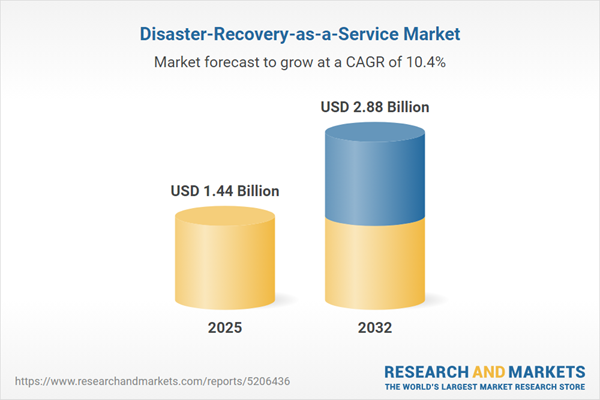Speak directly to the analyst to clarify any post sales queries you may have.
Disaster-Recovery-as-a-Service (DRaaS) is establishing itself as a core element of modern enterprise continuity planning, equipping organizations with the flexibility required to face today’s complex digital and operational threats. As more companies reshape their infrastructure strategies, robust DRaaS adoption remains critical to maintaining organizational resilience amidst an evolving risk landscape.
Market Snapshot: The Disaster-Recovery-as-a-Service Market
The Disaster-Recovery-as-a-Service market grew from USD 1.30 billion in 2024 to USD 1.44 billion in 2025 and is set to maintain strong momentum at a CAGR of 10.40%, projected to reach USD 2.88 billion by 2032. Market expansion is underpinned by increased adoption of cloud-native strategies and mounting challenges such as regulatory compliance, cyberattack sophistication, and the need for agile data protection. Global organizations are placing heightened focus on scalable solutions that deliver rapid failover, enhanced validation, and broad geographic coverage, further driving demand across all sectors and regions.
Scope & Segmentation of the DRaaS Market
This analysis provides a comprehensive view across service offerings, deployment preference, organizational size, key verticals, and geographic markets.
- Service Types: Backup and Restore (including file- and image-based backup), Hot Standby, Pilot Light, and Warm Standby.
- Deployment Models: Hybrid Cloud, Private Cloud, Public Cloud.
- Organization Sizes: Large Enterprises, Small and Medium Enterprises (SMEs).
- Industry Verticals: Banking, Financial Services, and Insurance; Education (Higher Education and K-12); Energy and Utilities (Oil and Gas, Power Generation, Water and Waste Management); Government (Central, Defense, State and Local); Healthcare (Providers, Medical Devices, Pharmaceuticals); IT and Telecom Services; Manufacturing (Automotive, Electronics); Retail (Brick and Mortar, Ecommerce).
- Regional Coverage: Americas (United States, Canada, Mexico, Brazil, Argentina, Chile, Colombia, Peru), Europe, Middle East & Africa (United Kingdom, Germany, France, Russia, Italy, Spain, Netherlands, Sweden, Poland, Switzerland, UAE, Saudi Arabia, Qatar, Turkey, Israel, South Africa, Nigeria, Egypt, Kenya), Asia-Pacific (China, India, Japan, Australia, South Korea, Indonesia, Thailand, Malaysia, Singapore, Taiwan).
- Leading Providers: Amazon Web Services, Microsoft, IBM, VMware, Dell Technologies, Hewlett Packard Enterprise, Cisco, Acronis, Veeam, Sungard Availability Services.
Key Takeaways for Senior Decision-Makers
- DRaaS has evolved from niche solutions to integral elements of business continuity, automating infrastructure recovery and reducing IT manual intervention.
- Cloud-native and hybrid architectures deliver the scalability and flexibility needed for both compliance-driven and growth-oriented enterprises.
- Integration of AI and machine learning streamlines anomaly detection, enhances predictive recovery, and minimizes downtime during operational incidents.
- Adoption patterns vary across industries; sectors like financial services, healthcare, and energy require tailored recovery and compliance validation, while education and retail value differentiated data protection across digital and physical assets.
- Strategic partnerships and consolidation among leading DRaaS providers support comprehensive coverage, from hyperscale orchestration to modular microservices-based tools embedded in CI/CD pipelines.
- Continuous validation, automated testing, and outcome-based service agreements align recovery objectives more closely with enterprise risk-management priorities.
Evaluating Tariff Impact on DRaaS Market Dynamics
Recent changes in United States tariffs have created additional cost considerations for DRaaS offerings. Providers and their enterprise clients face increased expenses on hardware components and networking equipment sourced from overseas suppliers. These changes are prompting contract reevaluations and strategy shifts, including hardware localization and diversified data center footprints. Enterprise buyers are adapting through workload optimization, increased automation, and hybrid failover strategies that balance costs against critical recovery requirements.
Methodology & Data Sources
This research combines in-depth interviews with industry executives, IT leaders, and security architects across sectors, structured secondary research from financial and regulatory sources, and proprietary data analysis. Insights are validated using statistical modeling, scenario simulation, and expert workshops to ensure precision and relevance for senior decision-makers.
Why This Report Matters
- Enables leaders to benchmark recovery and resilience strategies against evolving global best practices and peer organizations.
- Supports selection of DRaaS solutions that align with compliance requirements, operational goals, and budget constraints across complex digital infrastructures.
Conclusion
Strategic DRaaS implementation underpins robust business continuity and agile response in a shifting risk environment. This report provides actionable, segment-specific insights to inform technology adoption and futureproof resilience planning for enterprise organizations.
Additional Product Information:
- Purchase of this report includes 1 year online access with quarterly updates.
- This report can be updated on request. Please contact our Customer Experience team using the Ask a Question widget on our website.
Table of Contents
3. Executive Summary
4. Market Overview
7. Cumulative Impact of Artificial Intelligence 2025
Companies Mentioned
The companies profiled in this Disaster-Recovery-as-a-Service market report include:- Amazon Web Services, Inc.
- Microsoft Corporation
- IBM Corporation
- VMware, Inc.
- Dell Technologies Inc.
- Hewlett Packard Enterprise Company
- Cisco Systems, Inc.
- Acronis International GmbH
- Veeam Software Group GmbH
- Sungard Availability Services LP
Table Information
| Report Attribute | Details |
|---|---|
| No. of Pages | 192 |
| Published | November 2025 |
| Forecast Period | 2025 - 2032 |
| Estimated Market Value ( USD | $ 1.44 Billion |
| Forecasted Market Value ( USD | $ 2.88 Billion |
| Compound Annual Growth Rate | 10.4% |
| Regions Covered | Global |
| No. of Companies Mentioned | 11 |









